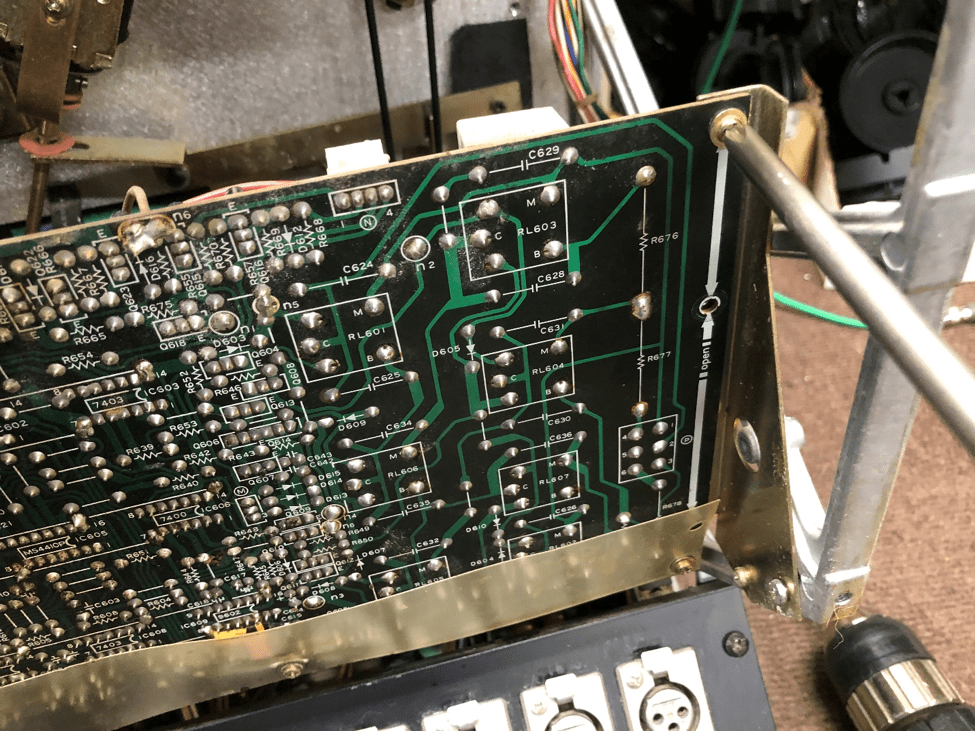It is our experience that the Otari 5050 can suffer from speed variations, especially after sitting unused for a bunch of years. There are generally two or three possibilities that can cause the speed to fluctuate:
- Defective motor, causing changes in the capstan RTM
- Dirty pitch control/pitch on/off switch, solved with control cleaner
- The pinch roller sleeve bearing assembly in the deck has partially seized up, preventing good contact between the pinch roller and the capstan shaft.
An actual defective motor is fairly rare on Otaris, as they are direct drive, and the motor control PC board generally is very reliable. We have seen the odd bearing seize up within the motor, however those generally are noisy as a result, and can be replaced. (the entire motor comes apart very easily)
The pitch control pot and on/off switch can be accessed through the rear of the deck, and can be hit with a contact cleaner spray solution (We use DeOxIt D5, available online).
The sleeve bearing that causes the pinch roller not to engage properly with the capstan shaft uses white grease, similar to that of Teac/Tascam machines, and it can gum up over time. Fortunately, resolving this is easy, and takes little effort and time.
The first thing to check is to grab the pinch roller from the front of the deck with the power off, and move it down manually with your fingers towards the capstan shaft. The ½” or so movement should be smooth, and the spring loaded assembly on the rear chassis of the deck should pull the pinch roller back out of the way as soon as you let go. If it’s difficult to move the pinch roller, then it’s time to clean out the old grease, and relubricate the bearing.
You will require:
- long Philips screwdriver
- small straight blade screwdriver
- heat gun or cigarette lighter
- general purpose oil
- cotton swabs
The first step is to take the pinch roller off the deck on the front. This is done by removing the Philips screw on the pinch roller cover, then slide the pinch roller off its shaft.

There is a decorative metal cap around the capstan shaft assembly that screws down onto the capstan motor. Unscrew that and remove it. If it hasn’t been unscrewed in a couple of decades, it may be partially seized in place. If so, you can undo the capstan motor from the back of the deck, and rotate the motor assembly from the rear while holding onto that metal cap. That will always undo it.

Take the back off the deck. There’s two screws on top, and four on the back of the deck. That then exposes the motherboard and transport.

The main motherboard/transport PC board is held into place by three screws down each side of the board. White arrows indicate these screws. Remove all 6. The PC board then flips down to a horizontal position, exposing the transport.

The capstan motor is held into place with 4 Philips screws. The one on the bottom of the motor is a bit difficult to reach, but can be done with a long Philips screwdriver.

Once the 4 screws have been removed, rotate the motor and the connected wires so that they are out of the way. Don’t set the motor on the PC board, as it may crack the board.

With the motor out of the way, here’s the problematic bearing. It’s a simple sleeve bearing, and the white grease hardens over time, causing sluggish operation of the pinch roller.

Remove the C clip and the washer that may be underneath it with a small straight blade screwdriver. Don’t let the C clip disappear, as it can shoot to a land far far away if you’re not careful!

The metal portion that moves the pinch roller up and down can now be pulled back off the main shaft. If the bearing is badly seized, you may need to use a heat gun or lighter to heat up the bearing assembly so that you can wiggle the lever assembly off the shaft by about an inch or so.

While you could do a bunch more disassembly to fully remove the lever assembly from the deck completely, you’d then throw off the calibration of the pinch roller, so our recommendation is to move the lever off the shaft as shown above. Use cotton swabs to clean off all the white/yellow grease from the shaft, and inside the sleeve bearing. A tiny amount of that white grease will seize up the bearing assembly completely, so there’s not a lot of grease in there.



Once the assembly is clean, with no more grease coming off the bearing, it’s time to relube the assembly. We put a couple of drops of oil onto the shaft of the bearing, and a couple of drops inside the sleeve assembly.


Once lubricated, slide the lever assembly back into place, and work that lever up and down a bunch of times to move the oil around. Wipe up any excess oil, and it’s time to reassemble the deck.
Here’s a picture of the spring that brings the pinch roller lever back to its resting position when the deck is in the STOP mode, or when the power is turned off.

Reinstall the motor, the transport PC board, and the back of the set.

With the pinch roller engaging properly, the deck speed should be back to normal.
